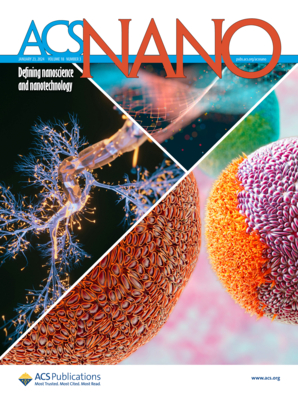Optimizing the Electronic Structure of Iron Oxides via Nonmetallic Dopants for Enhanced Peroxidase Mimetic Catalysis.
IF 16
1区 材料科学
Q1 CHEMISTRY, MULTIDISCIPLINARY
引用次数: 0
Abstract
Efficiently enhancing the activity and selectivity of targeted nanozymes is a challenging task, primarily due to the inherent structural stability and heterogeneous atomic composition of traditional nanozymes. Herein, theoretical design is carried out to select Fe-based oxides (FO) nanozymes with high peroxidase (POD)-like activity by incorporating different nonmetallic atoms (N, P, S, and B). Among these dopants, B emerged as a superior candidate because it could effectively tune the adsorption energies of *OH intermediates and *H2O2, thereby endowing the nanozymes with superior POD-like performance. Leveraging this insight, Bdoped Fe-based oxides (FOB) is successfully synthesized, demonstrating remarkable POD-like activity and ultrafast reaction kinetics. Mechanistic investigations revealed that B doping enhances electron transfer and intermediate adsorption by increasing the electron density and reducing the coordination number of the Fe center, concomitantly lowering the energy barrier for hydroxyl radical (·OH) formation and the rate-determining step. As a proof of concept, a three-enzyme cascade colorimetric biosensor integrating acetylcholinesterase (AChE)-choline oxidase (ChOx)-POD is constructed to perform ultrasensitive and selective detection of AChE activity and inhibitors. This study establishes a novel framework for designing high enzyme-mimicking performance transition-metal oxide nanozymes with doping nonmetallic atoms, provoking an inspiration for the rational design of nanozymes by regulating the electronic and coordination environment.非金属掺杂优化铁氧化物的电子结构以增强模拟过氧化物酶的催化作用。
有效地提高靶向纳米酶的活性和选择性是一项具有挑战性的任务,主要是由于传统纳米酶固有的结构稳定性和不均匀的原子组成。本文通过引入不同的非金属原子(N、P、S和B),对具有高过氧化物酶(POD)活性的铁基氧化物(FO)纳米酶进行了理论设计。在这些掺杂剂中,B可以有效地调节*OH中间体和*H2O2的吸附能,从而使纳米酶具有优异的pod样性能,因此成为较好的候选。利用这一见解,成功合成了b掺杂铁基氧化物(FOB),显示出显着的pod样活性和超快反应动力学。机理研究表明,B掺杂通过增加电子密度和降低Fe中心配位数,降低羟基自由基(·OH)形成的能垒和速率决定步骤,增强了电子转移和中间吸附。作为概念的证明,构建了一种整合乙酰胆碱酯酶(AChE)-胆碱氧化酶(ChOx)-POD的三酶级联比色生物传感器,用于超灵敏和选择性地检测AChE活性和抑制剂。本研究建立了掺杂非金属原子设计高仿酶性能过渡金属氧化物纳米酶的新框架,为通过调节电子和配位环境来合理设计纳米酶提供了启示。
本文章由计算机程序翻译,如有差异,请以英文原文为准。
求助全文
约1分钟内获得全文
求助全文
来源期刊

ACS Nano
工程技术-材料科学:综合
CiteScore
26.00
自引率
4.10%
发文量
1627
审稿时长
1.7 months
期刊介绍:
ACS Nano, published monthly, serves as an international forum for comprehensive articles on nanoscience and nanotechnology research at the intersections of chemistry, biology, materials science, physics, and engineering. The journal fosters communication among scientists in these communities, facilitating collaboration, new research opportunities, and advancements through discoveries. ACS Nano covers synthesis, assembly, characterization, theory, and simulation of nanostructures, nanobiotechnology, nanofabrication, methods and tools for nanoscience and nanotechnology, and self- and directed-assembly. Alongside original research articles, it offers thorough reviews, perspectives on cutting-edge research, and discussions envisioning the future of nanoscience and nanotechnology.
 求助内容:
求助内容: 应助结果提醒方式:
应助结果提醒方式:


